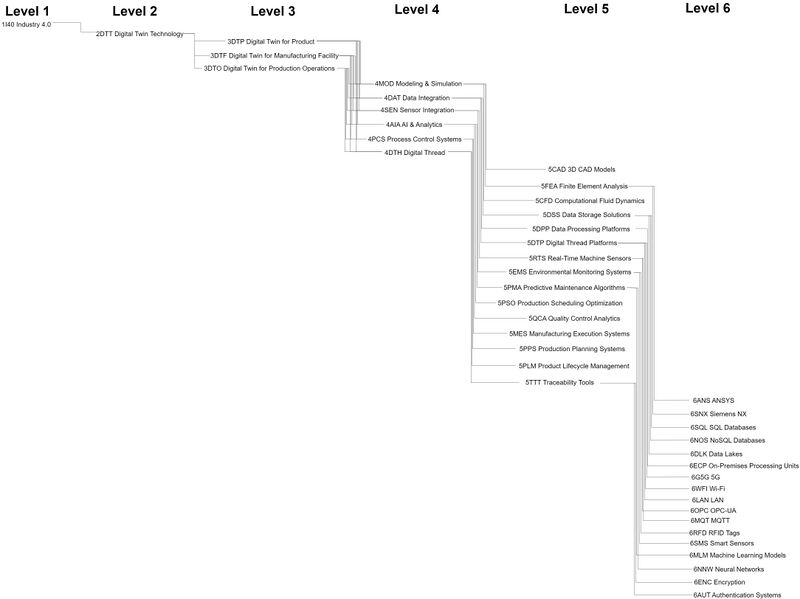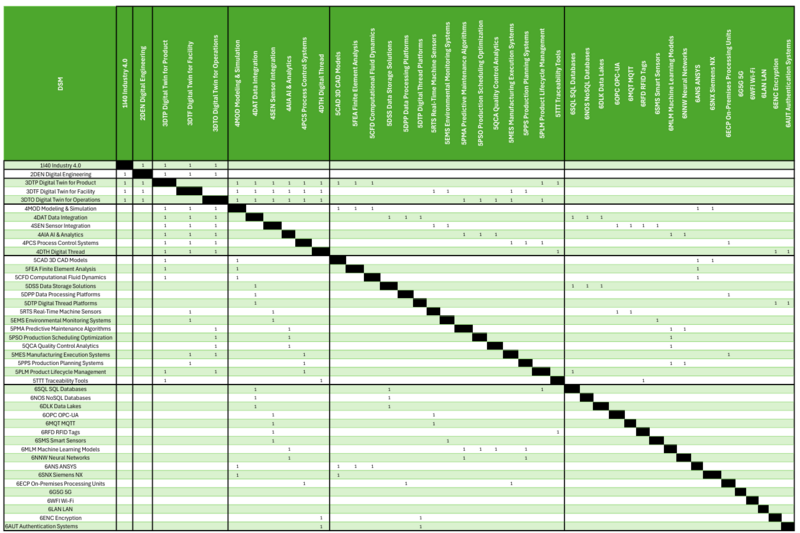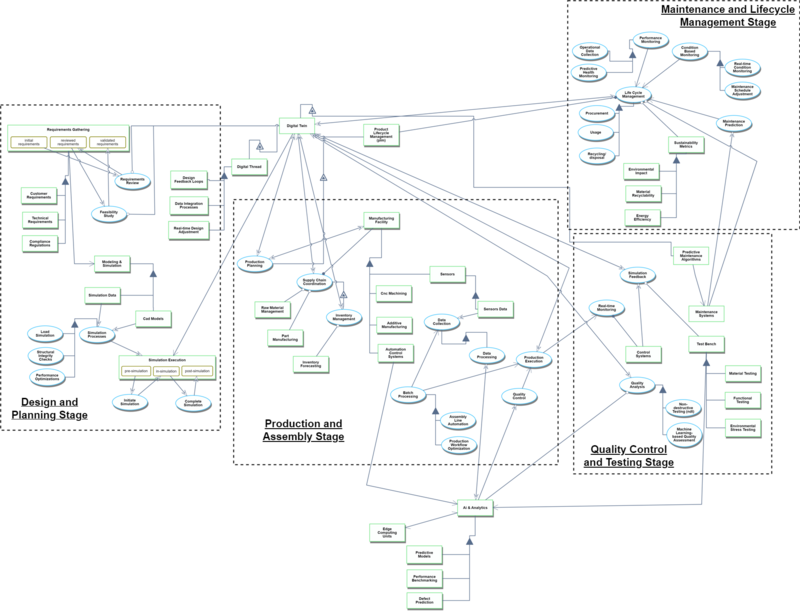Digital Twin Technology
Technology Roadmap Sections and Deliverables
Our technology roadmap identifier is shown as:
- 2DTT - Digital Twin Technology
This identifier represents a Level 2 technology roadmap focused on product-level aspects of Digital Twin Technology. The roadmap is segmented into various tiers, with each level becoming more granular and specific as it progresses.
Level 1 (Market Level):
- It focuses on the broader market context for Embraer to revolutionize its manufacturing facilities, primarily focusing on Industry 4.0.
- The market demands, and technological trends that drive the need for Digital Twin solutions are addressed here.
Level 2 (Product/Technology Level):
- This is the product or overarching technology level, dealing with the general 2DTT Digital Twin Technology and its strategic significance to industry needs.
- Level 2 encompasses the overall architecture and essential components of Digital Twin, such as Physical Technology Integration and Smart Industry Platforms.
Level 3 (System/Facility Level):
- The roadmap breaks down into system-level components where the Digital Twin is implemented across specific systems or facilities.
- Key areas covered include technology implementation in product, facility, and operations. Level 3 covers end-to-end integration and system-level optimization.
Level 4 (Subsystem Level):
- At this level, the subsystems and digital enablers are detailed, such as Modeling & Simulation, Sensor Integration, CAD Data Integration, AI & Analytics, Process Control Systems, and Digital Threads.
- Level 4 subsystems are pivotal in effectively deploying Digital Twins across different environments.
Level 5 (Component Level):
- The roadmap moves to specific components like Edge Units, Real-Time Monitoring Sensors, Data Storage Structures, Predictive Maintenance Algorithms, and Quality Control Analysis.
- Level 5 components ensure the robust performance of digital twin models by continuously feeding real-time data and predictive insights into the system.
Level 6 (Technology or Tool Level):
- Finally, at the most granular level, individual technologies or tools such as AI/ML Models, Encryption Mechanisms, Authentication Systems, and Digital Twins Interoperability Tools are addressed.
- Level 6 elements ensure that the Digital Twin systems are secure, scalable, and integrated with other enterprise systems.
Technology Overview
Implementing a digital twin in Embraer’s aircraft manufacturing facility is an essential step towards realizing Industry 4.0, characterized as the Embraer 4.0 strategy by 2030. The field of Digital Engineering defines Digital Twin as a virtual representation of physical assets, processes, systems, or products that serve as a real-time representation throughout the system development lifecycle. The Aircraft Manufacturing Facility’s Digital Twin is a seamless integration of Data Handling, System Integration, Modeling, Simulation, and Digital Thread Implementation.
As per Embraer's Digital Twin strategy, defined by the Industry 4.0 Vertical Team, it primarily addresses three critical challenges:
- a) Infrastructure
- b) Business Processes
- c) Digital Thread
In addition, the successful realization of Digital Twin also encompasses:
- i) Establishing robust system integration
- ii) Optimizing data storage
- iii) Processing capacities
- iv) Evaluating ROI
- v) Managing transformative changes
The Digital Twin Strategy is intended not to be realized in a vacuum but well integrated with other ongoing Digital/AI Transformation efforts. This includes 'Generative AI models which will play an essential role in enabling Digital Twins to simulate and optimize manufacturing processes, adapt to unforeseen scenarios, and generate innovative solutions.
The diagram Progress of Digital Twin Technology from 1943 to 2024 illustrates how Digital Twin has evolved over the years regarding its capability to integrate available data for specific complex systems. Historical events have been used as Data points to illustrate the critical milestones in Ditial Twin, incorporating technologies such as Neural Networks, Computer Aided Engineering (CAE), Computer-Aided Design (CAD), and Cognitive Learning capabilities. The evolution graph uses Data Integration Equation to track the progression of capability development of Digital Twin, with each historical milestone appearing to mark an increase in data integration.
Design Structure Matrix (DSM) Allocation
The above 2DTT Digital Twin Technology decomposition and Design Structure Matrix (DSM) visualize the complex layers of technology integration essential for next-generation systems. Starting at 1I40 Industry 4.0, the framework trickles down through key enablers like 2DEN Digital Engineering and 3DTF Digital Twin for Facilities, connecting all the way to component-level technologies such as 4MOD Modeling & Simulation, 4SEN Sensor Integration, and 5PMA Predictive Maintenance Algorithms. These lower-level elements at levels 4 and 5 don't operate in silos, and their interdependencies within the DSM reveal a dynamic, real-time interplay that facilitates continuous system optimization. By illustrating the interaction between subsystems like 4PCS Process Control Systems and 5DPP Data Processing Platforms, the matrix demonstrates how each layer contributes to the holistic advancement of digital twins—from high-level frameworks to operational intelligence. As data integration reaches new heights, the DSM paves the way for intelligent, adaptive systems that drive scalability, efficiency, and innovation, establishing the Digital Twin as the linchpin of future industrial transformation.
Roadmap of Digital Twin Technology OPM
The Digital Twin roadmap outlines a comprehensive flow across multiple lifecycle stages, incorporating the design and planning, production and assembly, quality control and testing, and maintenance and lifecycle management stages. At the core is the Digital Twin, which integrates data from sensors and real-time monitoring systems to simulate, optimize, and adjust virtual models of aircraft products, manufacturing facilities, and operational systems. Through the Digital Thread, a continuous feedback loop is maintained, connecting the aircraft's design, production, and operational performance. The roadmap includes processes such as Data Collection, Simulation Execution, Predictive Maintenance, Quality Control, and Lifecycle Monitoring, ensuring that the digital and physical realms are synchronized for efficient production, real-time operational adjustments, and sustainable lifecycle management. Advanced AI Analytics and Predictive Algorithms enhance the system's ability to monitor and predict outcomes, while interdependencies between the Supply Chain, Manufacturing Process, and Product Design are continuously optimized for enhanced productivity, scalability, and environmental sustainability. This approach ensures a seamless integration of all stages, enabling precise decision-making and high operational efficiency.






